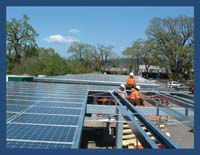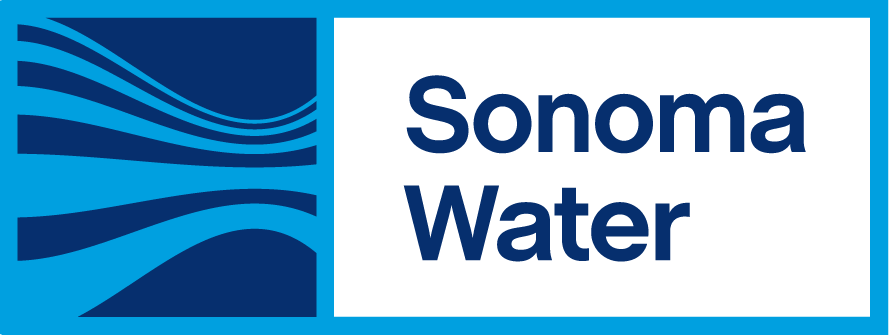To meet the goals of the Carbon Free Water Program, Sonoma Water has implemented several energy production, energy purchasing, energy efficiency, and sustainability projects. Below is the list of projects completed and currently underway.
Photovoltaic SystemsSonoma Water has four photovoltaic systems that total to about 2 MW. The administration building has a 0.5 MW system that has panels flush on the roof and panels on a carport-like structure in the parking lot. The Airport Larkfield Wastewater Treatment Plant has a 0.5 MW fixed system that is ground mounted around the edge of one of the storage ponds. The Sonoma Valley Wastewater Treatment Plant has a 1.0 MW tracking system that is ground mounted in a field adjacent to a storage pond. Sonoma Water continues to investigate additional opportunities for solar power generation. The most recent ground mounted solar installment is that of Geyserville Treatment Plant, which has a 50 kW system. For more information, visit the Photovoltaic Systems page. |  |
Warm Springs Hydroelectric DamDue to the unique enabling legislation establishing Sonoma Water during the late 1940s, Sonoma Water was given authority to produce both water and power. At the time, most energy needs were met by hydropower resources. However Sonoma Water didn't exercise this power aspect until after the Warm Springs Dam was completed in 1984. A hydroelectric turbine was installed a few years later and has been producing electricity since then. This turbine is capable of generating 2.6 MW of power. Since energy production is influenced by the flow of water through the dam, power production is usually at about 1.3 MW. Annual energy production ranges from 9,000 MWh to 15,000 MWh depending on wet vs. dry years which determine the water releases through the turbine. Sonoma Water collaborates with the Army Corps of Engineers in the operation of the hydroelectric dam. Sonoma Water contractually buys and sells the energy generated to/from the Power and Water Resources Pooling Authority (PWRPA). As a PWRPA member, Sonoma Water is also given access to other cost-effective non-fossil fuel resources throughout the state. | |
Wind Turbine - Geyserville Sanitation ZoneIn 2013, a wind turbine was erected at the Geyserville Sanitation Zone wastewater treatment plant. The purpose of this partially grant funded project was to develop and test a model for a locally owned, cost-effective, renewable wind energy that would help Sonoma Water reach its greenhouse gas reduction goals. Unfortunately, this project didn't demonstrate the cost-effective aspect of expectations. An essential aspect of the Carbon Free Water program is cost-effectiveness. Nonetheless this provided a learning opportunity for the community and for Sonoma Water that wind energy in this area is not a viable renewable resource. Although our own wind generating capacity is small, Sonoma Water also contracts buys some wind power from Marin Clean Energy's Deep Green program. |
|
Sonoma Clean PowerIn 2011, the Sonoma Water Board of Directors instructed Sonoma Water to investigate Community Choice Aggregation (CCA) while concurrently approving Sonoma Water’s Energy Policy. Community Choice Aggregation allows one or more cities and/or counties to form a service area that provides for the option to purchase power generation from local sources that has a different electricity mix than that of the original investor owned utility. Creating competition in the electricity generation market, by creating choice in energy providers, is good for the community and the environment by driving electricity rates to be most competitive while also having a choice in the types of energy you can purchase. Transmission, distribution, customer service and billing remain the same (delivered through the existing utility PG&E). Customers within this service area can opt out of participating in the CCA program and continue to receive their power generation services through the existing investor owned utility--although the starting generic rate for Sonoma Clean Power's Clean Start Program is both cheaper and less GHG intensive than that of PG&E's generic generation services. Learn more about Sonoma Clean Power. | |
Hybrid, Plug-In Hybrid & Electric Vehicle FleetSonoma Water is currently electrifying our fleet with electric, plug-in hybrid, and hybrid vehicles. Since 2006, we've seen a reduction of GHGs by over 85% in our overall carbon footprint. This was entirely due to our electricity supply alone. Now, our largest source of GHGs is our transportation related fleet emissions. Sonoma Water purchased its first hybrid electric vehicle in 2006. As of 2017, Sonoma Water has 26 hybrid, plug-in hybrid and electric vehicles, which is 20% of the fleet of vehicles. | |
Recycling ProgramSonoma Water has an active recycling program at its administration building and its operations and maintenance center. Paper, plastics, glass, and aluminum cans are all recycled with the help of designated bins in the kitchens, copy rooms, conference rooms, and cubicles. Recycled paper is ordered for copiers and printers and recycled presentation materials are used whenever possible. Sonoma Water annually hosts an e-waste recycling event with the Computer Recycling Center. Large bins are provided on site for employees to contribute personal and office e-waste items. Sonoma Water also recycles ink cartridges from its printers. | |
Water Education & Conservation ProgramsSonoma Water has well-established water education and conservation programs. Over the last several years, the Mike Hauser Algebra Academy is hosted at Sonoma Water's administrative office. Here, Sonoma Water staff in the Energy Resources Group teach middle school students about the relationship between energy systems and environmental science. For more information about the Water Education program, click here. For more information about the Water Conservation Program, click here. |






